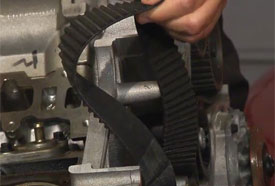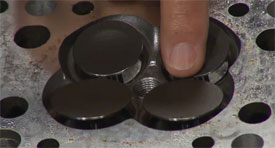Timing Belts
Timely changing of your timing belt is an often overlooked car care service, and that’s not good! And Pat Goss tells us why down at Goss’ Garage.
 For many years, vehicle manufacturers have elected to use timing belts to drive the camshafts in the top of the engine to operate the valves that let fuel into the engine and let exhaust out. But these belts, well, they’re made of rubber and they ware out over time so they need periodic replacement. Well, there’s a big concern here; number one, is the engine in your car and interference engine or a non interference engine? You see, interference engines it’s been known for a long time, there can be a lot of engine damage if the belt breaks.
For many years, vehicle manufacturers have elected to use timing belts to drive the camshafts in the top of the engine to operate the valves that let fuel into the engine and let exhaust out. But these belts, well, they’re made of rubber and they ware out over time so they need periodic replacement. Well, there’s a big concern here; number one, is the engine in your car and interference engine or a non interference engine? You see, interference engines it’s been known for a long time, there can be a lot of engine damage if the belt breaks.
Now, what does interference mean? While the pistons are moving up and down and if the belt breaks with the piston moving up like this up towards to top of its stroke, and the valves in that cylinder come to rest in the open position such as we see here, the piston hits the valve and bends the valve. Well, that’s a major repair.
But the idea has always been, if you have a non interference engine, you have nothing to worry about. So money’s tight, you’re just going to put off changing the belt for a while and if it breaks, no big deal. Well, that may not be the case.
 See, in the last few years, there’s been a lot of cars that have gone to dual cam heads; they have two camshafts. Now, you may have an engine that is listed as non interference, and that means valve to piston interference. Yet, if the two camshafts stop in the right position, you can actually have interference between the two valves. These don’t actually touch, but in some engines, they can touch and they can bend each other. So, even though you have a non interference engine, as far as the book is concerned, you may have a valve to valve interference engine. So, you still don’t want to put off changing that timing belt. The reason is, no matter what happens, if the belt breaks, you could have a situation where you either have piston to valve interference or valve to valve interference and that’s going to cost you some big bucks.
See, in the last few years, there’s been a lot of cars that have gone to dual cam heads; they have two camshafts. Now, you may have an engine that is listed as non interference, and that means valve to piston interference. Yet, if the two camshafts stop in the right position, you can actually have interference between the two valves. These don’t actually touch, but in some engines, they can touch and they can bend each other. So, even though you have a non interference engine, as far as the book is concerned, you may have a valve to valve interference engine. So, you still don’t want to put off changing that timing belt. The reason is, no matter what happens, if the belt breaks, you could have a situation where you either have piston to valve interference or valve to valve interference and that’s going to cost you some big bucks.





